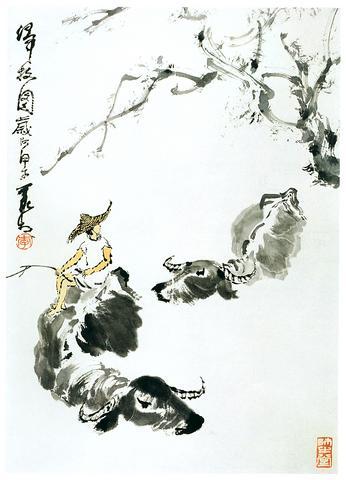Dai Dong-ni (
Over 100 originals by some 60 Chinese master painters have been gathered under one roof for viewers to appreciate up close. These include: Wu Chang-shuo's (
Dai Mei-ling (

PHOTO COURTESY OF NCA
The Changan school of paintings is one of the main categories of Dai Family's collection. Shi Lu (
Gao Chian-fu (
Fu Bao-shi (傅抱石), a well-known figure of the Chingling school, was the first painter to disregard the painting tradition of leaving blank space on the panel. His Landscape series, in which minimalist human figures appear against rugged, overwhelming cliffs, powerfully evokes the magnificence of central Chinese mountains.
Horses are Hsu Bei-hong's most celebrated subject. Hsu applied his knowledge of anatomy to painting the joints and calves of the horses and insisted on reserving one particular brush for painting the tail. These characteristics are evident in Hsu's Horse, on show at the exhibition.
Among other rare finds are Empress Dowager Zi Hsi's (
Collection of 19th to 20th Century Genuine Traditional Chinese Painting and Calligraphy will run through March 21 at National Cultural Association, 15 Chongqing S Rd., Sec 2, Taipei (

In the March 9 edition of the Taipei Times a piece by Ninon Godefroy ran with the headine “The quiet, gentle rhythm of Taiwan.” It started with the line “Taiwan is a small, humble place. There is no Eiffel Tower, no pyramids — no singular attraction that draws the world’s attention.” I laughed out loud at that. This was out of no disrespect for the author or the piece, which made some interesting analogies and good points about how both Din Tai Fung’s and Taiwan Semiconductor Manufacturing Co’s (TSMC, 台積電) meticulous attention to detail and quality are not quite up to

April 21 to April 27 Hsieh Er’s (謝娥) political fortunes were rising fast after she got out of jail and joined the Chinese Nationalist Party (KMT) in December 1945. Not only did she hold key positions in various committees, she was elected the only woman on the Taipei City Council and headed to Nanjing in 1946 as the sole Taiwanese female representative to the National Constituent Assembly. With the support of first lady Soong May-ling (宋美齡), she started the Taipei Women’s Association and Taiwan Provincial Women’s Association, where she

Chinese Nationalist Party (KMT) Chairman Eric Chu (朱立倫) hatched a bold plan to charge forward and seize the initiative when he held a protest in front of the Taipei City Prosecutors’ Office. Though risky, because illegal, its success would help tackle at least six problems facing both himself and the KMT. What he did not see coming was Taipei Mayor Chiang Wan-an (將萬安) tripping him up out of the gate. In spite of Chu being the most consequential and successful KMT chairman since the early 2010s — arguably saving the party from financial ruin and restoring its electoral viability —

It is one of the more remarkable facts of Taiwan history that it was never occupied or claimed by any of the numerous kingdoms of southern China — Han or otherwise — that lay just across the water from it. None of their brilliant ministers ever discovered that Taiwan was a “core interest” of the state whose annexation was “inevitable.” As Paul Kua notes in an excellent monograph laying out how the Portuguese gave Taiwan the name “Formosa,” the first Europeans to express an interest in occupying Taiwan were the Spanish. Tonio Andrade in his seminal work, How Taiwan Became Chinese,